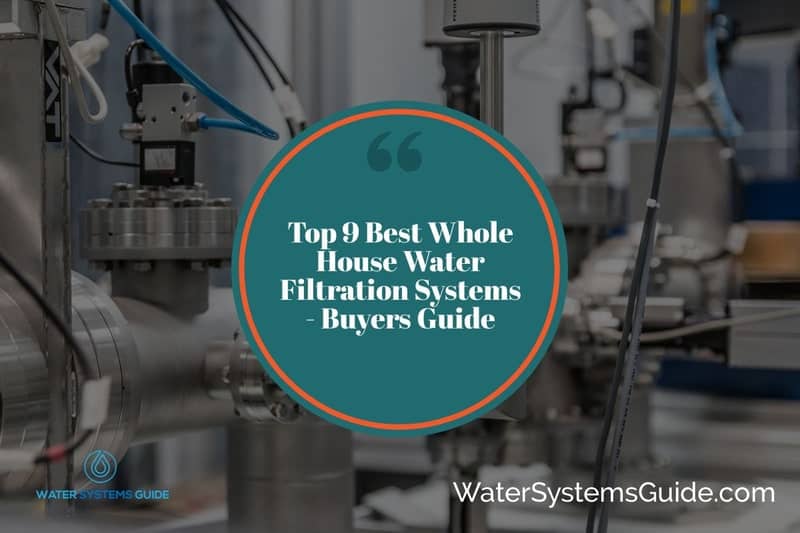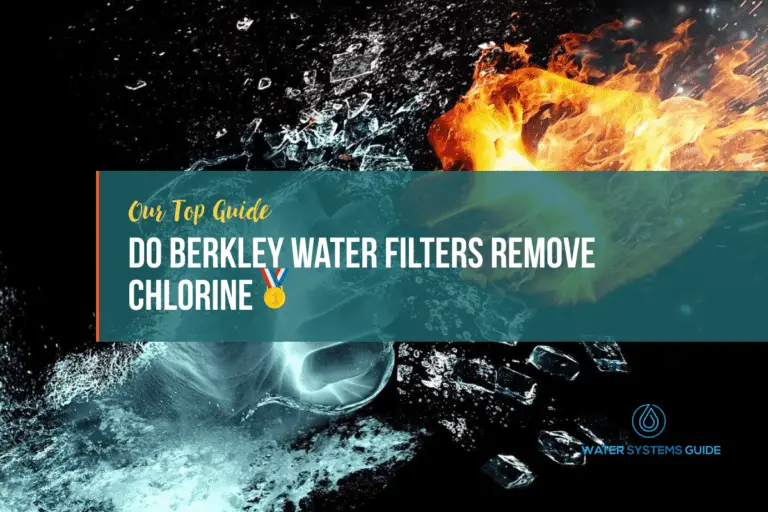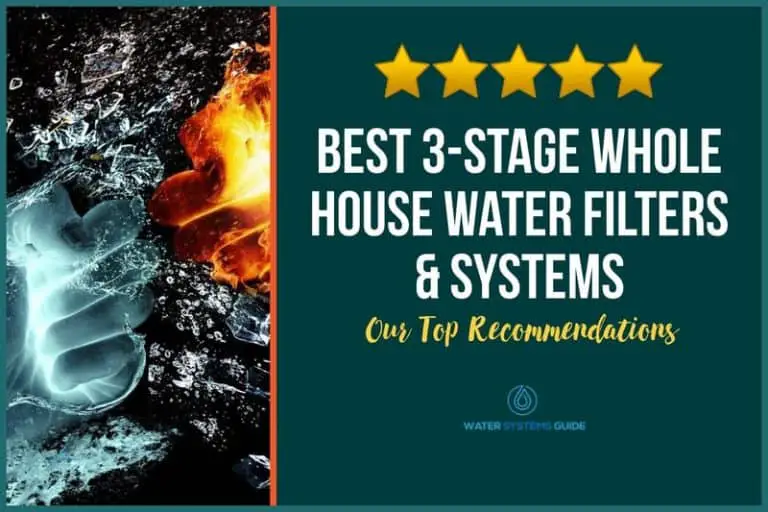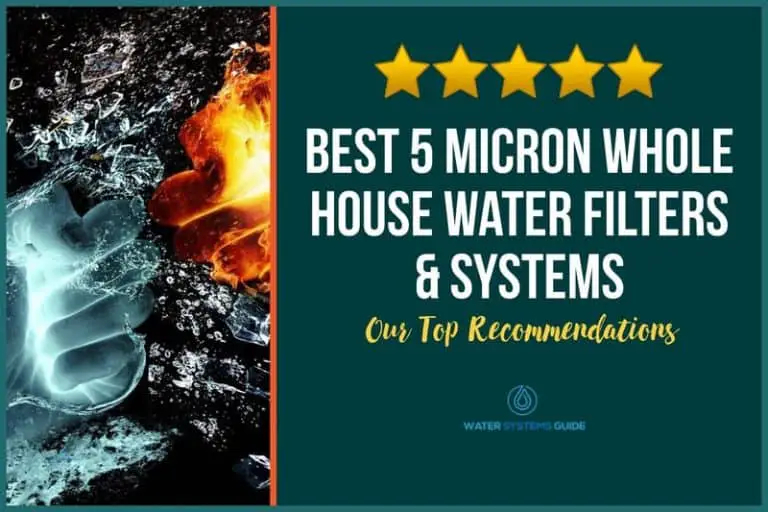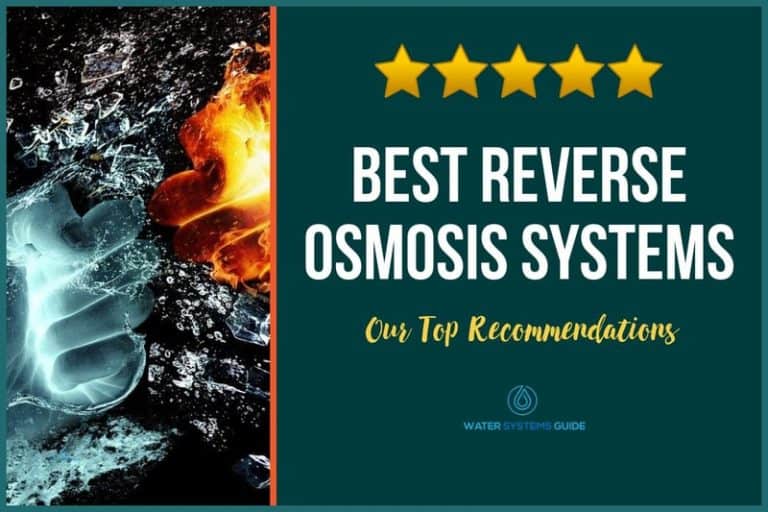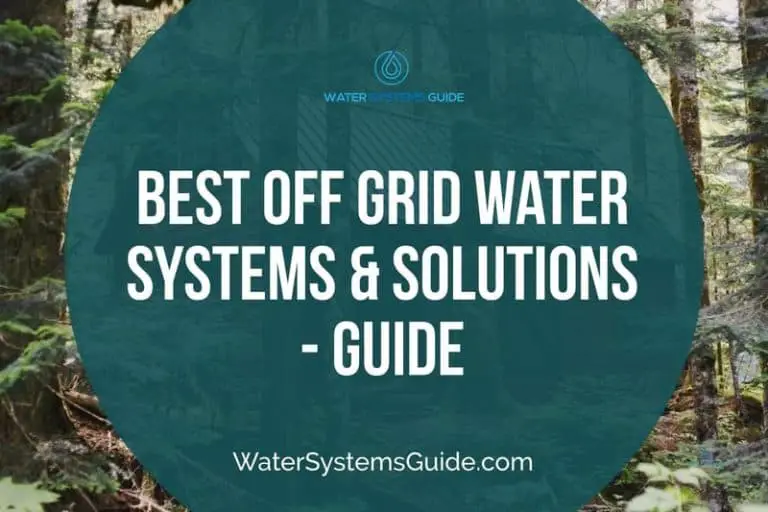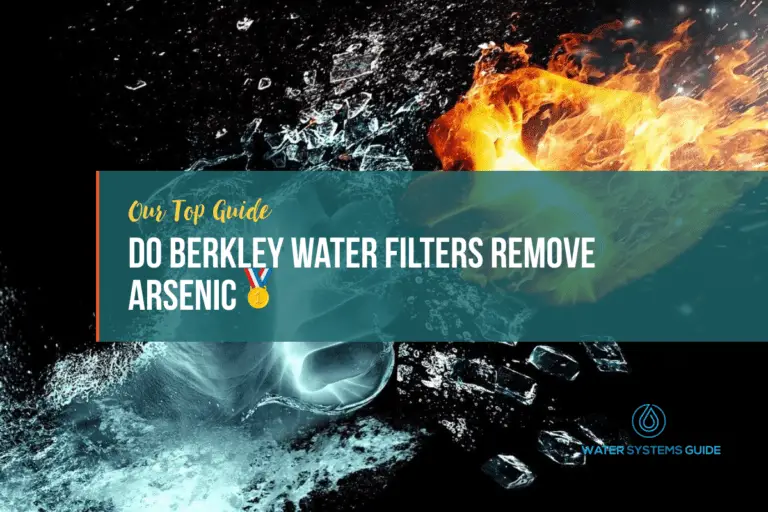Top 10 Best Whole House Water Filtration Systems (April 2025)🥇
Last Updated: 09 April 2025
In this article, we’re going to be talking about the best whole house water filter systems available on the market.
In addition to removing pollutants from your potable water supply, these whole house water filters also improve the smell and the taste of the same. On top of that, it reduces water’s hardness to make sure that it gives you a healthy-looking hair and skin, and leaves fewer stains on your dishes.
That said, not all house water filter systems are created equal.
That means that if you want to get the best home water filtration system, what you need is someone identifying the features which separate the best units from the also-rans. At the same time, you need to have one eye on your budget to make sure that you get good value for your money.
Think that’s something that’s beyond you? Don’t worry as this article will help you out.
✅What is a whole house water filter system?
As the name implies, a whole house water filter removes impurities, pollutants and other harmful substances from the tap water of your home. It is able to do that by installing a point-of-entry system which works by channeling all the water through a filtration media.
That means that in contrast to, say, under sink water filter system models, you won’t see multiple water filters of the same whole house system throughout your house. Instead, it has a standalone water filter that gets the job done on its own.
💧What are the benefits of using whole house water filter systems?
Following are the benefits which you can incur:
Ameliorate taste of water
Provided your tap water is giving off an unpleasant taste, that means it contains chloramine in small amounts. That said, water that contains more fluoride than usual also tends to give off a peculiar odor.
Regardless of the reason, having a whole house water filtration system would make sure that your water supply contains no smell. So you can drink it without any adverse effects on your health.
Makes water safe
What do you call water which doesn’t give off an unpleasant odor and doesn’t taste funny? That’s right; water which your entire household can safely drink.
That’s exactly what these whole house water filters, by removing chemicals, pollutants, and other harmful substances from your house water spply, do. Hence making sure that you and your family members remain hale and hearty.
Make water healthy
In contrast to what most people might believe, the functionality of such whole house water filters isn’t limited to removing potentially harmful and disease-causing substances from your drinking water.
Instead, provided you’ve purchased a high-end model, it might be capable of adding healthy minerals to the water, thereby improving its quality and making it healthier.
Encourage kids’ development
Regardless of which pediatrician you might consult, they’d tell you that safe water plays an important role in the physical and mental development of kids by eliminating waste products from their organs.
Or else, if your kids are drinking unsafe water, that might expose them to water-borne diseases such as typhoid or dysentery, harming their well-being.
Low running price
Imagine you have two filtration systems in your home. One of them has as many water filters as the number of faucets in your household. Other, slightly bigger one, filters the entire water which your house receives at a single point.
Now tell me: which of these systems would be less pricey to maintain? Of course the whole-home water filtration system. So here’s another reason why you should go for house water filters.
🚰Top considerations before you buy
To get the best whole house water filter system, you have two options, the first of which requires you to go to Amazon, scour through house water filter reviews, and manually find the features which users recommend to have in water filters.
Or you can just go through this section and have all the information that you need.
Water Quality
First things first, you need to identify the quality of water supply which you’re receiving in your home. Provided you do that, that would allow you to pinpoint the pollutants that are coming with it, i.e heavy metal. That, in turn, would allow you to buy a whole house water filter which is specifically made for those pollutants, and is, therefore, able to provide you and your family with clean drinking water.
For instance, here are some of the types of water which you might be receiving:
Municipal water
Assuming that it’s your municipality or local administration that is supplying water to your doorstep, you have two ways to have its water quality checked.
First, you can send a sample to an independent lab. Or, you can purchase and use water testing equipment.
Provided you do that, the water testing equipment will let you know the type of pollutants that might be present in your water and what type of filter might better deal with it.
Well water
In contrast to municipal water – which might contain excessive amounts of fluoride, trihalomethanes and haloacetic acids, well water might be polluted with chemicals, pesticides, heavy metal and even fertilizers.
The list of pollutants that might end up in well water is endless. What you need to do, therefore, is to identify which of them are coming to your home.
Filter Types & Longevity
Once you’ve identified the pollutants in your house water, the next step involves getting a filter that is designed to remove the same. Fortunately for you, you don’t have to expend much mental effort as whole house water filters are available in two types only.
Carbon Tank models
Available in two types – activated carbon and carbon block – these models don’t require electricity to run, remove pollutants while retaining healthy nutrients in water, and have low operating as well as an upfront price.
However, if your tap water requires certain chemicals such as nitrates, fluorides, and toxic minerals, an activated carbon/carbon block water filter might not be the best option for you. Though they do last longer.
Cartridge type models
Some of the best whole house drinking water filters systems use a combination of models to target specific chemicals or pollutants amongst your house water.
This arrangement is recommended if you want your water filter to target specific pollutants in your house water.
That said, since they have a cartridge that requires frequent replacement, the operating prices of such d might sky-rocket if you have high water requirements.
Water Flow Rates & Micron Ratings
Interestingly, a filter’s flow rate and its micron rating are two features that contradict each other. In other words, if a filter has a high flow-rate, its micron rating – which is a measure of how effectively a water filter removes pollutants from your water supply – will be less.
What we need, therefore, is to find a balance between both these features.
Water Flow Rate
Provided you don’t already realize it, a whole house water system must provide enough rate to power your bathrooms, kitchen, dishwasher, and all other appliances that run on water.
Therefore, once you add up the water requirements of all these separate filters, you’d need to have a filter whose water flow rate must exceed 10GPM at the very least for a medium-sized home.
Micron rating
As most of you might already know, a micron rating is an indicator of how much pollutants a liquid water filter might remove from your house water based on their size.
Still, as stated earlier, you cannot view the micron rating in isolation, as with the increase in its number, the flow rate will decrease. What you need to do, therefore, is to find a good balance between both. However, higher micron rating generally allow for cleaner drinking water.
Filter Prices & Lifespan
You came to this article not only because you wanted the best whole house filtration system for your needs. Instead, you also wanted a model that provided great value for your money. And no water filter can claim to do that until its lifespan is more than a decade.
Water Filter Prices
In contrast to what most users might believe, your spending on a filter doesn’t end after purchasing. Instead, you’d have to keep spending money to keep it up and running as well.
Therefore, when buying a model, make sure that you keep both these prices (upfront and running) into account before making a decision.
Lifespan
Assuming that you’ve decided in favor of an carbon filter, it will last longer and would require replacement of its filtration media once every 5 years or so.
Conversely, if you intend to target more specific pollutants and have therefore gone for a cartridge type filter, you should brace yourself for replacing its media every 6-12 months.
Physical Space
Given the volume of water, they’re required to treat, it should go without saying that whole house water filters are much bigger than, say, their under-sink counterparts. Provided you have decided to purchase one of them, make sure that your house has enough space for housing the water filter.
💧What is the best house water filtration system?
While you might accuse us of being trying to be politically correct after reading the next part of this sentence, it’s clear as a sunny day that all the products that we recommend to you in this review are best in their own right.
While some improve the water’s taste and odor, others purify it from harmful chemicals, pollutants, heavy metals, and allergens. And since we don’t know what your requirements are, it is you and not anybody else who can pinpoint one particular system as the best for your needs, allowing for whole house filtration.
Best Whole House Water Filters Review – Top 10
- iSpring WGB22B 2-Stage Whole House Water Filter – 80,000 Gal – $ – Skip to section
- Home Master Whole House System – 95,000 Gal – $$ – Skip to section
- iSpring WGB22BM Whole House Water Filter – 100,000 Gal – $ – Skip to section
- iSpring WGB32B 3-Stage Whole House Water Filter – 100,000 Gal – $$ – Skip to section [#1 Recommendation – Highly Affordable, 3-Stage Filter, 99% Cl & F− Removal]
- Express Water Whole House Water Filter – 100,000 Gal – $$ – Skip to section
- Apex 3-Stage Whole House Water Filter – 20,000 Gal – $$ – Skip to section
- Aquasana Whole House Water Filter System – 1,000,000 Gal – $$$ – Skip to section [#2 Recommendation – Affordable, Ultra High Gallon Capacity, 97% Cl & F− Removal]
- Aquasana Rhino Whole House Water Filter – 300,000 Gal – $$$ – Skip to section
- Aquasana Rhino Whole House Water Filter – 600,000 Gal – $$$$ – Skip to section
- Aquasana Rhino Whole House Water Filter – 1,000,000 Gal – $$$$$ – Skip to section
iSpring WGB22B 2-Stage Whole House Water Filter – $
The iSpring WGB22B is a 2-stage whole house system that relies on a residue and carbon filter to eliminate all the commonly found contaminants from your house water. Throw into the mix its excellent flow rate of 15 gallons per minute, and you can’t find much that is wrong with this water filter.
Technical Specs
- Filter Stages: 2
- Micron: 5 and 5
- Rate: 15GPM
- Capacity: 80,000 Gal
- Fluoride & Chlorine Removal: Up to 99%
General Specs
- Price: $
- Dimensions: 5 x 8.5 x 26 inches
- Weight: 33 pounds
- Kit includes: black metal bracket, two big blue housings with caps, two filter cartridges, and a 4. 5-inch housing wrench, house water filtration system
- Warranty: 1-year
Features
First things first, the fact that this unit comes with two-stages means it gets one-up over units that use on one cartridge to purify your water. The first of them is a 5-micron high filter capacity residues/sediment filter which, as the name implies, eliminates silt, dust, and residues.
As for the second of the two filters, it relies on carbon block material to not only freshen up the taste and eliminate odor from your water but also keep the likes of chlorine, pesticides, herbicides and even VOCs at bay, thereby making the entire unit suitable for municipal or city treated waters.
Compared with other whole house water filters you can find on the market, the installation of the iSpring WGB22B is perhaps the easiest. All you’d have to do is to attach the inlet and outlet pipe against the PVC header, before connecting the PVC pipe to your house’s plumbing using a proper sealer.
Other than that, since the housing of both filters is equipped with the same 1’’ port, that allows the filter to provide an excellent water flow rate of up to 15GPM. The filters supply up to 80,000 gallons of water before needing replacement, which translates to 1 year of water treatment for a family of 4.
What we don’t like
Reviews suggest that the installation of the unit can require steady hands, making sure that the inlet and outlets are secure.
Pros
- Rate of 15GPM
- 80,000 gallons of water filtering capacity
Cons
- Installation requires steady hands
Home Master Whole House System – $$
Although this unit lacks behind the iSpring WGB22B water filter when it comes to its rate, the fact that it filters out particles with a smaller micron size and boasts a higher filtering capacity makes the Home Master Whole House Water Filter a formidable option too.
Technical Specs
- Filter Stages: 2
- Micron: 1
- Rate: 10GPM
- Capacity: 95,000 Gal
- Fluoride & Chlorine Removal: Up to 95%
General Specs
- Price: $$
- Dimensions: 9 x 18 x 25 inches
- Weight: 4 pounds
- Kit includes: fully assembled Home Master Filter system with filters, steel mounting bracket with bolts, housing wrench, and instructions, water filtration system.
- Warranty: 2-year
Features
Starting with the best that this unit has to offer, its catalytic filter provides a full year of clean house water by treating 95,000 gallons before needing replacement. That too while making sure that both of its filters eliminate particles as small as 1 micron from your house water.
Turning our attention to how it would keep the contaminants out, this 2-stage filter relies on a combo of an outer residues sediment filter and an inner catalytic filter to keep things clean, with the external filter preventing the likes of dust, dirt and other particles from making their way into the system.
As for the internal catalytic filter, its high-grade coconut shell empowers the filter to eliminate taste, odor, and chemicals from your house water. The granular activated media of the filter, meanwhile, allows it to keep the likes of heavy metals (lead, copper, and mercury) away from your water.
Furthermore, since this system is equipped with a standard 1-inch port, you can expect to get more than 10GPM of rate at all times. Granted, it isn’t as impressive as the one offered by the iSpring WG22B, but the flow rate of this unit is better than what is offered by most water filters on the market.
What we don’t like
What is it that we don’t like about this unit? Neither of the two filters which are supplied alongside the unit doesn’t come cheap.
Pros
- Filters particle as fine as 1 micron
- Market-best volume
- Impressive rate
Cons
- Considerable water filter replacement prices
iSpring WGB22BM Whole House Water Filter – $
In contrast to the other iSpring unit which we reviewed earlier – whose specialty lies in its fine residues and carbon filters – the iSpring WGB22BM, apart from dealing with the normal contaminants, proves its utility when dealing with the likes of iron, manganese and other heavy metal substances.
Technical Specs
- Filter Stages: 2
- Micron: 5
- Rate: 15GPM
- Capacity: 100,000 Gal
- Fluoride & Chlorine Removal: Up to 99%
General Specs
- Price: $
- Dimensions: 16 x 8 x 27 inches
- Weight: 40 pounds
- Kit includes: black metal bracket, two big blue housings with caps, two filter cartridges, and a 4. 5-inch housing wrench,
- Warranty: 1-year
Features
What makes the iSpring WGB22BM different from other units from the same manufacturer is its ability to protect your household appliances. It reduces the likes of iron and manganese sediment from your water to make sure that when used for washing, it doesn’t end up leaving scales on your appliances.
What’s more, while whole house reverse osmosis systems are undoubtedly more popular, this unit shows that you could do better without reverse osmosis systems. That is, because, while reverse osmosis systems treat everything in the same fashion, this device ignores the healthy minerals and lets them pass through.
Moving on, while the first of the two stages main eliminate taste, odor and other commonly found pollutants, the 2nd stage is where this unit shows its true worth. Made of iron and magnesium reduction filter, it chiefly eliminates iron, arsenic, and manganese from source water.
Despite being so picky while dealing with contaminants, this unit provides the same 15GPM flow rate which is offered by most iSpring units. One area where this unit performs better than its colleagues is its volume. While most of them stop short at 85,000 gallons, this device goes all the way up to 100,000.
What we don’t like
Once you factor in the yearly replacement prices of the cartridge – which exceeds $100 – and this unit comes across as an expensive system.
Pros
- 100,000 gallons filtering capacity
- Eliminates iron and manganese
- Allows healthy minerals to remain
Cons
- Pricey
iSpring WGB32B 3-Stage Whole House Water Filter – $$
#1 Recommendation – Highly Affordable, 3-Stage Filter, 99% Cl & F− Removal
The iSpring WGB32B filter is for those of you who are satisfied with the performance of the manufacturer’s 2-stage filters but want more protection for your household against contaminants which the first 2 stages can’t keep out.
Technical Specs
- Filter Stages: 3
- Micron: 5
- Rate: 15GPM
- Capacity: 100,000 Gal
- Fluoride & Chlorine Removal: Up to 99%
General Specs
- Price: $$
- Dimensions: 21 x 8 x 28 inches
- Weight: 49 pounds
- Kit includes: 5″ x 20″ 5 Micron High-volume Polypropylene Residues sediment Filter (FP25B), 4.5″ x 20″ 5 Micron CTO Block Filter (FC25B), Filter housing wrench and user manual, water filtration system
- Warranty: 1-year
Features
Of the 3 individual filters which this unit comes with to keep your household safe, the first one focuses on removing residues, silt and similar dirt particles from your house water. The second filter, whose internals are made of carbon black, rids your water of taste, odor, herbicides, and VOCs.
As for the 3rd stage, it completes the process started by the 2nd stage filter. Any contaminants which were able to bypass the 2nd stage would be caught here, and since this unit has the same carbon block filter as that of its predecessor, it will send the pollutants to oblivion.
Moreover, this filter demolishes the myth that multi-stage filters can’t provide a decent rate. It provides the same 15GPM flow rate which its 2-stage counterparts provide and can handle a formidable volume of up to 100,000 gallons.
Lastly, when the time comes to replace the filter, you won’t have to expend much time and effort to do the need. All you would have to do is to just open the filters’ casing with the supplied wrench, twist off the existing filter, twist on the new one and you’d be good to go.
What we don’t like
Although the 2nd and 3rd stage block filters last 12 months no matter what, an increased concentration of residues in your house water might force you to replace the first water filter a bit early.
Pros
- 3-stage filtration
- Eliminates herbicides, pesticides, and VOCs
- Filters are easy to replace
- All three cartridges meet ANSI/NSF standards
Cons
- Residues sediment filter might last less long
Express Water Whole House Water Filter – $$
Who says 3-stage water filters cannot compete with their 2-stage counterparts when it comes to flow rate and volume it can handle? With the Express Water Whole House Water Filter, you can see for yourself that in contrast to what most people believe, you can have the best of both worlds.
Technical Specs
- Filter Stages: 3-stages
- Micron: 5
- Rate: 15GPM
- Capacity: 100,000 Gal
- Fluoride & Chlorine Removal: Amount not displayed
General Specs
- Price: $$
- Dimensions: 5 x 8.5 x 29.5 inches
- Weight: 8 pounds
- Kit includes: 3 filter cartridges, 1-inch connections, pressure gauges, etc, water filtration system
- Warranty: 1-year
Features
As you might have guessed by now, each of the 3 stages of this whole house water filter serves a specific purpose. While the first sediment filter cartridge eliminates residues and other dirt particles, the 2nd filter would keep the likes of taste, odor, and chlorine from making their way into your faucets.
The 3rd part of this trinity has an activated black filter to protect against pesticides, herbicides, VOCs and all other chemicals. Add together the utility of all three cartridges, and what you get is water that is as safe for cooking as it is for drinking purposes.
Yet another great feature of this unit is the pressure gauge located on top of each cartridge. Equally impressive is the see-through design of the casings of all three cartridges, which allows you to monitor your system and see from outside when it’s time to replace the filter.
When the time has arrived to replace the cartridges, all you’d have to do is to simply twist off the housings with the drop-and-go design making filter change a cinch. Also, since the overall frame is capable of standing on its own, you don’t necessarily have to mount it.
What we don’t like
Some of the users of this product argue that its ¾’’ FPT inlet and outlet connections are too loose, so you’d have to use not only Teflon tape but also pipe dope to prevent leakage.
Pros
- High capacity filtration
- See-through design
- Freestanding stainless steel frame
- Three pressure gauges
Cons
- Inlet and outlet connections are loose
Apex 3-Stage Whole House Water Filter – $$
The Apex 3-Stage whole house water filtration system is built for eliminating most impurities that can make their way into your municipal water. Also, since all three of its filters are housed in the same casing, it’s price-effective for the user to maintain them.
Technical Specs
- Filter Stages: 3
- Micron: 5
- Rate: 15GPM
- Capacity: 20,000 Gal
- Fluoride & Chlorine Removal: Amount not displayed
General Specs
- Price: $$
- Dimensions: 30 x 24 x 12 inches
- Weight: 2 pounds
- Kit includes: House water filtration system
- Warranty: 1-year
Features
In contrast to its single-stage counterparts, the Apex 3-Stage filter kicks off the process by removing large residues particles, followed by the removal of chlorine and chemicals in its 2nd stage. Then comes the 3rd pass of filtration which eliminates odors, smells and pungent substances from water.
Furthermore, none of the filters tamper with the rate and allow you to draw water at a rate of 15 gallons per minute. You can also keep on using the same cartridges for 6 months because all of them have the volume to handle 20,000 gallons.
What’s more, you don’t have to waste any time to try and install this unit since it comes 100% pre-assembled and ready to mount. Also, since this unit doesn’t employ reverse osmosis technology, you don’t need electricity to keep it running.
To further sweeten the deal, Apex has provided this unit with a 100% satisfaction and quality guarantee, which means that if for any reason you aren’t satisfied with its performance, you can either have the unit replaced or get a full refund.
What we don’t like
Compare the water-handling volume of this unit with other units in this review, and you’d see that at 20,000 gallons, its cartridges last less long.
Pros
- BPA-free materials
- Considerable rate
- Offers 100% satisfaction guarantee
Cons
- Relatively low capacity
Aquasana Whole House Water Filter System – $$$
#2 Recommendation – Affordable, Ultra High Gallon Capacity, 97% Cl & F− Removal
Provided you can set aside a few hours to install this unit – as its installation isn’t for the novice – the Aquasana Whole House water filter system would prove its usefulness.
Technical Specs
- Filter Stages: 4
- Micron: Sub-micron
- Rate: 7GPM
- Capacity: 1,000,000 Gal
- Fluoride & Chlorine Removal: 97%
General Specs
- Price: $$$
- Dimensions: 9 x 46 x 44 in
- Weight: 5 pounds
- Kit includes: filtration tank, 20″ pre-filter, post-filter, brass fittings, bend supports, and shut-off valves – Fittings for 0.75” pipe, house water filtration system
- Warranty: 10-year
Features
First things first, this system delivers filtered water for the whole home for up to 10 years or 1 million gallons, though you’d have to regularly replace its pre-filters. It offers a chlorine removal system which helps get rid of 97% of the same that may have found its way into your municipal water.
Versatility is yet another strong feature of this unit, as it lets you choose the kit which meets your requirements. You can choose from an optional chloramines filter, the pro kit, salt-free softener with filter, and salt-free softener with filter and UV water tester.
You can also modify this system to complement the house water configuration of your home. Apart from the pro kit, it provides a four-stage filtration process to solve all your water problems. A 5-micron pre-filter lets this unit eliminate residues and microscopic particles.
At the second stage, you get a tank filled with crushed minerals and copper-zinc to eliminate 97% of chlorine, with the result that you get alkaline pH water. The third stage, meanwhile, has an inner filter to eliminate traces of chloramine, while an additional UV filter eliminates bacteria and viruses.
What we don’t like
Considering that most households have 1’’ pipes, it was puzzling for us to note that this unit has fittings for 0.75’’ pipes. That means you might have to purchase an adapter.
Pros
- 1 million gallons
- Eliminates 97% of chlorine
- UV filtration kills bacteria
- Sub-micron pro sediment filter
Cons
- Fittings aren’t the standard size
Aquasana Rhino Whole House Water Filter (300,000 Gal.) – $$$
Certified by NSF to eliminate over 97% of chlorine present in tap water, the Aquasana Rhino whole house water filter reduces the hardness of water to protect your appliances from its effects.
Technical Specs
- Filter Stages: 4
- Micron: Sub
- Rate: 7GPM
- Capacity: 300,000 Gal
- Fluoride & Chlorine Removal: 97%
General Specs
- Price: $$$
- Dimensions: 20 x 10 x 48 inches
- Weight: 71 pounds
- Kit includes: filtration tank, 20″ pre-filter, post-filters, brass fittings, bend supports, and shut-off valves – Fittings for 0.75” pipe, house water filtration system
- Warranty: 10-year
Features
To make sure that you can drink, wash, shower, and do more with clean water, the Aquasana Rhino uses four stages. The first stage is a residues pre-filter which reduces the amount of rust, residues, and silt in your tap water.
The second stage, which is made of Cu-Zinc and mineral stone fiber, uses high-grade activated carbon filter media to reduce herbicides, pesticides, and other chemicals. Then comes the third phase whose bacteriostatic blend helps it to eliminate chlorine and improve the taste and odor of your water.
After passing through the 3-stages, water then passes through what Aquasana refers to as the water conditioner. This stage helps reduce the scale build-up properties of water to prevent it from damaging your pipes and appliances.
Lastly, just like most of the Aquasana whole-house systems, the Rhino also comes with a 10-year guarantee. It provides a maximum flow rate of 15GPM – which is enough for a full home of 4 bathrooms – and has cartridges which last 6 months on average.
What we don’t like
In a shortcoming which might prove to be a deal-breaker for some of you, this unit’s flow rate is a meager 7 gallons per minute.
Pros
- 300,000 gallons
- Comes with a 6-year warranty
- Compact and lightweight
Cons
- Low rate
Aquasana Rhino Whole House Water Filter (600,000 Gal.) – $$$$
Certified by NSF to eliminate over 97% of chlorine present in tap water, the Aquasana Rhino whole house water filter reduces the hardness of water to protect your appliances from its effects.
Technical Specs
- Filter Stages: 4
- Micron: Sub
- Rate: 7GPM
- Capacity: 600,000 Gal
- Fluoride & Chlorine Removal: 97%
General Specs
- Price: $$$$
- Dimensions: 20 x 10 x 48 inches
- Weight: 71 pounds
- Kit includes: filtration tank, 20″ pre-filter, post-filters, brass fittings, bend supports, and shut-off valves – Fittings for 0.75” pipe, house water filtration system
- Warranty: 10-year
Features
To make sure that you can drink, wash, shower and do more with clean water, the Aquasana Rhino uses four stages. The first stage is a residues pre-filter which reduces the amount of rust, residues, and silt in your tap water.
The second stage, which is made of Cu-Zinc and mineral stone fiber, uses high-grade activated carbon filter media to reduce herbicides, pesticides and other chemicals. Then comes the third phase whose bacteriostatic blend helps it to eliminate chlorine and improve the taste and odor of your water.
After passing through the 3-stages, water then passes through what Aquasana refers to as the water conditioner. This stage helps reduce the scale build-up properties of water to prevent it from damaging your pipes and appliances.
Lastly, just like most of the Aquasana whole-house systems, the Rhino also comes with a 10-year guarantee. It provides a maximum flow rate of 15GPM – which is enough for a full home of 4 bathrooms – and has cartridges which last 6 months on average.
What we don’t like
In a shortcoming which might prove to be a deal-breaker for some of you, this unit’s flow rate is a meager 7 gallons per minute.
Pros
- 600,000 gallons
- Comes with a 6-year warranty
- Compact and lightweight
Cons
- Low rate
Aquasana Rhino Whole House Water Filter (1,000,000 Gal.) – $$$$$
Certified by NSF to eliminate over 97% of chlorine present in tap water, the Aquasana Rhino whole house water filter reduces the hardness of water to protect your appliances from its effects.
Technical Specs
- Filter Stages: 4
- Micron: Sub
- Rate: 7GPM
- Capacity: 1,000,000 Gal
- Fluoride & Chlorine Removal: 97%
General Specs
- Price: $$$$$
- Dimensions: 20 x 10 x 48 inches
- Weight: 76 pounds
- Kit includes: filtration tank, 20″ pre-filter, post-filters, brass fittings, bend supports, and shut-off valves – Fittings for 0.75” pipe, house water filtration system
- Warranty: 10-year
Features
To make sure that you can drink, wash, shower and do more with clean water, the Aquasana Rhino uses four stages. The first stage is a residues pre-filter which reduces the amount of rust, residues, and silt in your tap water.
The second stage, which is made of Cu-Zinc and mineral stone fiber, uses high-grade activated carbon filter media to reduce herbicides, pesticides and other chemicals. Then comes the third phase whose bacteriostatic blend helps it to eliminate chlorine and improve the taste and odor of your water.
After passing through the 3-stages, water then passes through what Aquasana refers to as the water conditioner. This stage helps reduce the scale build-up properties of water to prevent it from damaging your pipes and appliances.
Lastly, just like most of the Aquasana whole-house systems, the Rhino also comes with a 10-year guarantee. It provides a maximum flow rate of 15GPM – which is enough for a full home of 4 bathrooms – and has cartridges which last 6 months on average.
What we don’t like
In a shortcoming which might prove to be a deal-breaker for some of you, this unit’s flow rate is a meager 7 gallons per minute.
Pros
- 1 million gallons
- Comes with a 6-year warranty
- Compact and lightweight
- Effective sediment filter
Cons
- Low rate
Conclusion
Whether you live in a one-room apartment, a condo, or a full-sized villa, there are units in this review that are capable of providing safe and healthful water to your entire household.
All you have to do is to identify what your requirements and you’ll be able to find the most suitable whole house water filter to remove fluoride and chlorine.
However, these are the units that are the ones that we recommend to most readers:
iSpring WGB32B 3-Stage Whole House Water Filter – 100,000 Gal – $$ – Skip to section [#1 Recommendation – Highly Affordable, 3-Stage Filter, 99% Cl & F− Removal]
Aquasana Whole House Water Filter System – 1,000,000 Gal – $$$ – Skip to section [#2 Recommendation – Affordable, Ultra High Gallon Capacity, 97% Cl & F− Removal]
Frequently Asked Questions
🚰How much is a whole house water filter?
Based on our survey of the market and the prices of the products you see in this review, whole house filtration drinking systems are available at prices ranging between $200 and $1000.
💧How does a house water filter system work?
Before we introduce you to their working mechanism, you should know that not all whole house water filters have a similar working mechanism. In fact, apart from the first three steps of the below-mentioned procedure – which are common in almost all whole house filters – it is entirely possible that your system might not have the last three steps.
With this disclaimer, here’s how whole house water filtration units work:
Step #1: Sediments Pre-filter
In contrast to where you might be living, as long as you’re receiving water directly from your municipality, there’s a very good chance that it would contain sediments. A sediment filter would help in this situation.
Hence the reason why most multi-stage water filters have a sediments-pre filter which does exactly as its name implies. Apart from capturing sediments, it also keeps the likes of rust and silt at bay.
Step #2: Activated Carbon filter
Is your water giving off an unpleasant smell? That means it might contain excessive amounts of spent chlorine and fluoride. To remove both these pollutants, an activated carbon water filter comes into play.
By working on a process known as adsorption – which means that the impurities would be trapped on the surface of the pores – the activated carbon filter removes impurities and chlorines from water.
Step #3: CU-Zn and Mineral-Stone filter
Provided your water contains chlorine and water-soluble heavy metals, both these substances will make their presence felt by developing scale on your dishes and algae inside your water pipes.
To ensure that you don’t have to deal with any of the abovementioned scenarios, the combination of copper-zinc and mineral stone filters removes chlorine and water-soluble heavy metals from your house water.
Step #4: Water-softer (optional)
Water which contains an excess amount of hard minerals tends to cause scale on the surface of your dishes. Having a water softener system, therefore, prevents this scenario from materializing.
Water filters with a water softener alter the structure of hard minerals into a crystal structure, thereby preventing them from binding. That, in turn, reduces scale build-up by up to 99.6%.
Step #5: Sub-micron Post Filter (Optional)
Don’t get confused by its name as the sub-micron post-filter is another incarnation of the sediment filter which we discussed in the first step, with the only difference lies in the size of particles it filters out.
For instance, while the pre-filter sediment filter prevents bigger particles from polluting your house water, the sub-micron post-filter has a low cut-off limit of 0.35 microns.
Step #6: UV Filter (Optional)
As is the case with water purifiers that employ UV technology, a UV water filter, too, removes bacteria and viruses that may be hiding away from human gaze in the running water.
That said, unless you’re extremely concerned about your health, we recommend that you opt against a UV filter for the simple reason that devices that offer this filter tend to weigh heavily on your pocket.
🚰Should you invest in a whole house water filter?
Following are some of the reasons why you need to invest in a whole house water filter:
Clean water to do anything with:
Whether you want clean water for drinking or cooking purposes, a high-end whole house filtrationsystem, by removing sediments, chlorine, heavy metals and chemicals from your water, would let you do that, with the help of its sediment filter.
Healthier showers and baths:
If your water contains chlorine or chloramines, taking a bath with it might result in headaches, reddened eyes, and dizziness. The only type of system that could save you from such a scenario is a whole house filtration system device.
Better looking hair and skin:
Experts are unanimous in their belief that taking a bath with unclean water is one of the biggest causes of hair fall. As for your skin, washing it with safe water would make it look softer and plump.
Bigger shelf-life of water-using appliances:
Provided your water is full of sediments, silt or salt it will love nothing more than damaging the interior of your household appliances that use water. Having whole house systems would save you from this nightmarish scenario.
💧How often should I change my water filter?
One of the most common questions pertaining to a whole house water filter is regarding to how often should one change their water filter. Fortunately, there’s one common date which all experts agree on: once every six months.
Still, this half-a-yearly ultimatum only applies if your water consumption is from small to moderate. If that’s not the case, you might have to change your filters earlier.
🚰What is the price to replace the system’s filters?
Primarily because all the units in this review – and on the market – offer different functionalities, there’s no single answer to this question. That means that while some single-filter water filters might price as less as $15 a year in filer-replacement prices, others, which offer multi-stage filtration, might force you to spend four times the amount for the same.
💧What are the benefits of using whole house water filter systems?
While you might accuse us of being trying to be politically correct after reading the next part of this sentence, it’s clear as a sunny day that all the products that we recommend to you in this review are best in their own right.
While some improve the water’s taste and odor, others purify it from harmful chemicals, pollutants, and allergens. And since we don’t know what your requirements are, it is you and not anybody else who can pinpoint one particular system as the best for your needs.
🚰How to install a whole house water filter?
Assuming that you have the right accessories and tools at hand, installing or replacing the whole house water filters shouldn’t take more than half-an-hour. That’s if you have done this sort of work before, otherwise, you should be done with the whole process of installing the house water filter in less than 20 minutes.
Tools You’ll Need
- Replacement cartridge
- Housing wrench
- Soapy water
- Household bleach
- Bucket
- Food-safe silicone grease
Step-by-Step Instructions (for a direct connect systems)
Follow the following steps to install the filter of your whole house water filter system:
- Step # 1:
Before getting started, turn off the house water. You might do that by closing the valve positioned at the main water line. Some water devices contain a built-in valve themselves to prevent water from coming in.
- Step # 2:
In this step, you’re going to drain your system of the water that may be lying inside it. To do that, open the faucets. Unless you haven’t noticed a significant drop in water flow, keep them opened.
- Step # 3:
Some house water filtration systems come with an outlet valve which drains the excess water of the system into your house, one thing which we don’t want. Therefore, if your system has it, you should close it now.
- Step # 4:
Before opening the house water system, we need to make sure that the pressure inside the filter isn’t strong enough to cause damage. One way we can make sure of that is by pressing the relief button on the filter for a couple of seconds.
- Step # 5:
Having drained the excess water now is the time to unscrew the housing. Use a wrench to do it. Make sure that you have an empty bucket in the range of your hands in case you have to deal with spilt water.
- Step # 6:
Once you have unscrewed the housing, the old cartridge will be lying defenseless in front of you. Since you aren’t going to need it in the things to come, throw away the spent cartridge.
- Step # 7: (Optional)
As you might guess, the presence of water inside the filter’s housing might make it a den for bacteria and dirt.
If you have some free time on your hands, you can clean the inside of the housing with a mixture of soapy water and household bleach. Don’t forget to rinse it out thoroughly afterward or else you might end up doing more harm than good.
- Step # 8:
To lubricate the housings, apply food-safe silicone greasing on them. Afterward, delicately place the housing back in its place. In case you feel that the O-shaped ring looks worn out, it’s recommended that you replace it.
- Step # 9:
Now is the time for you to place the new cartridge in exactly the same place from where you lifted its worn-out counterpart earlier. Tighten its screws by hand and properly seat the O-shaped ring to minimize the chances of any leakages.
- Step # 10:
Having re-installed the cartridge, turn the house water back on. You can do that by opening all the valves which you had earlier closed in the first step. Follow up by checking for leaks.
- Step # 11:
Housings are the first area in which you should check for leaks. If you can see water dripping out, turn off the house water and tighten all the connections. That should be enough to stop the leakage.
- Step # 12:
Once again open the house water as well as the valves which take the water away from the main water filter and towards your home. Follow up by opening several faucets at the same time. That will remove any air that might have accumulated inside your system early on.
- Step # 13:
Once you sense that the water flow rate and pressure are back to their pre-filter cleaning normal, close the faucets. That’s it, you’ve successfully installed the new filter of your main water filter!
💧What is the best whole house water filter for well water
Undoubtedly, the iSpring WGB32B 3-Stage filter is the best for this purpose. Apart from removing the usual pollutants like chlorine, chloramine, and residues – which are mostly found in well water – this filter takes no chances by removing chemicals, herbicides and pesticides as well.
🚰What are the main drinking water pollutants?
As experts at the US Environmental Protection Agency tell us, following are the substances that might contaminate your drinking water.
Physical Pollutants:
Such substances which affect not only the physical appearance of water but also its other physical properties i.e. texture, odor, melting and boiling points are known as physical pollutants.
Common examples of sediments include sediments or any other organic material which may have found its way into the water as a result of soil erosion.
Chemical Pollutants:
As you might already know, chemical contaminants are compounds or elements which can either be man-made or naturally-occurring. They result in causing water-borne diseases.
Examples of chemical contaminants include bleach, pesticides, metals, nitrogen, and human as well as animal drugs. The toxins which are produced by bacteria are yet another example.
Biological Pollutants:
Such substances exist in the form of organisms in the water. You might see some research papers referring to them as either microbiological or microbes’ contaminants.
These contaminants exist in many forms including viruses, parasites, and protozoan. Though the most common form – one which can be found in ill-kept municipal water – is bacteria.
Radiological contaminants:
At the price of being technical, radiological contaminants have an unbalanced number of protons and neutrons which combine to result in unstable atoms that emit ionizing radiation to pollute the house water.
Unless you live right next to a nuclear reactor or a nuclear power plant, you have no need to worry about these substances finding their way into your home’s house water.
💧Should you buy a single-stage or multi-stage filter?
Both the single-stage as well as the multi-stage water filters have their own pros and cons. To help you in selecting the best one for your needs, let’s compare both these types of filters.
Single-Stage Devices
These are the most basic type of devices as most of them have little more than a sediment pre-filter to keep the likes of salt, silt and dirt particles away from your house water. That means that you can’t use to them filter out advanced contaminants.
That said, it isn’t that there isn’t anything right with these units. While they might not be good against advanced pollutants, it’s a fact that most households only need a basic filter as their area isn’t that polluted. Also, these water filters provide better flow-rate and tend to be cheaper than multi-stage filters.
Pros– Inexpensive – Low running price – Provide better rate |
Cons– Won’t capture advanced water contaminants |
Multi-Stage Devices
Provided your house water contains a copious amount of chemical and biological contaminants – those which a single-stage filter simply ignores before letting them go past it – a multi-stage filter might be what you need. They employ several types of cartridges to improve your water’s taste, color, and odor.
What’s more, while multi-stage devices do have a smaller rate than their single-stage counterparts, they more than make up for this shortcoming by being more efficient. Still, if you want to take advantage of what they have to offer, you’ll have to spend more on both the running and capital prices.
Pros– Captures most contaminants – Improve water’s taste, odor, and color – Retain healthy nutrients |
Cons– Expensive |
🚰How do you know what size water filter your home needs?
Assuming that you have 3 bathrooms in your home, that doesn’t mean that a filter that states that it can cater to “1-3 bathrooms” would meet your requirements. That is, because, it is entirely plausible that the size of your bathroom’s faucet might be different than the one which the filter took into account when measuring its flow rate.
Therefore, the best way to size a water filter is to measure the flow rate (in gallon per minute or GPM) of all the faucets in your home. Afterward, compare it with the GPM which the filter claims to supply. Only buy those devices whose rate is at least 0.5GPM more than your requirement.






